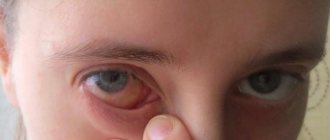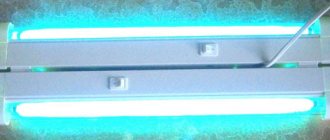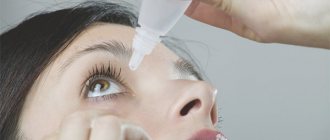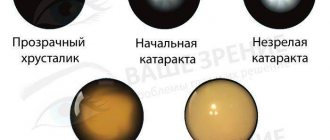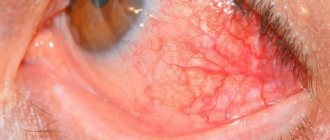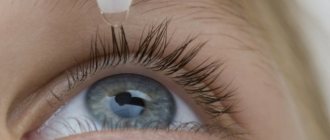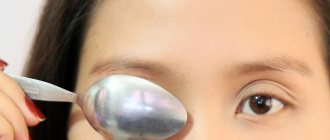Eye patch, sunglasses or prosthetic?
How to live with one eye? This question is asked by people who have lost an eyeball due to injury or illness. Naturally, they have a strong complex and try in every possible way to hide the defect from others with the help of dark glasses or an eye patch. However, such “disguise” is far from ideal and has many disadvantages.
An eye patch attracts undue attention from others, making a person feel shy. It's fair to say that scary headbands look good on pirates from historical films, but not on people in everyday life. As for tinted glasses, they are not always appropriate and in winter they cause confusion among passers-by. And they look quite strange indoors. Consequently, both of these methods are not suitable for everyone and not always.
Thanks to the development of science and modern technology, today there is an excellent way to hide the absence of an eye. This can be done with the help of a prosthesis, which in appearance is practically no different from the eyeball. The implant is placed in a specially formed cavity and remains there for a certain time. Different types of prostheses are subject to scheduled replacement every few years.
Types of eye prostheses:
- Glass . Quite light, have a smooth surface and are well moistened by tear fluid. Requires careful handling and careful use. Such dentures need to be changed once a year.
- Plastic . Much stronger and safer to use than glass. They are resistant to external influences, so patients with one eye can wear them much longer. The service life of such prostheses is two years.
- Standard . Produced in mass quantities. They have different shapes, sizes, colors, etc. Note that there are different types of prostheses for the right and left eyes. They try to choose the most suitable implant for each person.
- Individual . Made to order, taking into account all the individual characteristics and desires of a person. Implantation of such a prosthesis allows you to achieve the highest quality cosmetic effect.
Men and women who have lost an eyeball should not despair. Many people live without an eye for many years and still lead a full life. The unsightly defect is hidden with the help of a prosthesis, and one can gradually adapt to monocular vision.
Is it possible to drive a car and get a license?
Can people with one eye get a license and drive a car? Yes, but only if certain conditions are met. Let's figure out whether a person with anophthalmia (an underdeveloped or completely absent eyeball) can drive a car and what is needed in this case to obtain a driver's license.
According to the legislation of the Russian Federation (Article 23 of Federal Law No. 196 “On Road Safety”), every driver must undergo mandatory medical examinations. If during the examination he is diagnosed with diseases that prevent him from driving, he will not be able to obtain a license.
A person does not have the right to drive a category B vehicle if visual acuity is below 0.6 in one eye and less than 0.2 in the other eye. Note that vision is checked with correction, that is, with glasses or contact lenses. This means that even a patient with a high degree of myopia can get behind the wheel, having previously selected a means of correction.
By law, people with one eye can drive a car equipped with parking sensors - an acoustic parking system. Since people with anophthalmia have impaired binocular vision, they need APS to avoid accidents.
Passing a medical examination to obtain a driver's license
The examination is non-standard. The medical commission is required to check a person’s vision. They take place at a driving school, if it provides such services, or at a local clinic. A certificate can be obtained from a private ophthalmologist. The document must have the doctor's signature and the hospital/doctor's stamp.
When examined by an ophthalmologist, they undergo a thorough examination, which includes:
- visometry;
- ophthalmoscopy.
These are mandatory tests. If necessary, the diagnosis is supplemented with other studies. The test is carried out with glasses or contact lenses, it depends on what correction device the patient uses.
A medical certificate is issued when a person goes through more than just an ophthalmologist. It will record the results from the surgeon, otolaryngologist, neurologist, psychiatrist, narcologist and therapist. You receive it within 1–2 days.
If you cannot pass all the doctors within a given period, you should remember that the results are valid for 20 days. During this time, the person will have time to visit the doctors and get a conclusion from the therapist. The certificate is valid for 12 months.
Author's rating
Author of the article
Alexandrova O.M.
Articles written
2031
about the author
Was the article helpful?
Rate the material on a five-point scale!
( 13 ratings, average: 4.69 out of 5)
If you have any questions or want to share your opinion or experience, write a comment below.
Adaptation to monocular vision
People who are blind in one eye from birth will never be able to have normal binocular vision. The fact is that their brain is simply not capable of providing depth of perception of the world. Such patients have nothing to compare their vision with, so they consider it quite satisfactory.
But for people with one eye who have lost the other during life, their vision may be partially restored over time. It will never be the same as before, but it can improve. As a rule, this requires 1–2 years. Over time, a person gets used to his condition and learns to perform everyday work. After the adaptation period is over, he can even drive with one eye while driving.
Features of life with one eye
People who have recently lost an eye have to relearn how to move and navigate space. At first, life with one eye may seem too difficult and unusual for them, but over time this will pass. The main thing is not to worry or despair.
Tips to help people with one eye quickly adapt to their new condition:
- Obstacles from the missing eye . People with anophthalmia have a narrowed field of vision, which may prevent them from noticing objects that are located to their side. Therefore, in an unfamiliar place or new room, they need to look around carefully so as not to stumble upon an obstacle.
- Grabbing objects . To take any item from a table, open a door, or shake an outstretched hand without missing a beat, you need to move very slowly. By turning your head, you can better assess the distance to an object and its location in space.
- Walking up the stairs . When going down the steps, a person with one eye needs to carefully monitor the railing - this will help avoid an extra step down and a painful push. On the street, the stairs can be replaced by observing the shadows of objects.
- Estimation of distance to objects . While on the street, distance can be determined using visual nuances. To do this, you need to carefully examine trees, traffic lights, and sidewalks. The size of an object gives an idea of how far it is located.
In medicine, anophthalmia is the absence of an eyeball. This condition occurs after surgical removal of an injured or diseased eye. People with anophthalmia lose binocular vision, making it extremely difficult for them to navigate in space.
Is it possible to get a license with 1 eye (category B)
In the order of the USSR Ministry of Health dated September 29, 1989 N 555, a number of diseases or defects are written for which the driver cannot drive (I am interested in point 5): 12.1. Motorcycles, scooters, scooters of all types and brands - category A
5. Decreased visual acuity depending on persistent clouding of the refractive media or changes in the fundus of the eye, refractive errors, as well as other organic reasons: a) corrected visual acuity below 0.6 in the best eye, below 0.2 in the worst. Acceptable correction for myopia and farsightedness is 8, OD, including contact lenses, astigmatism is 3, OD (the sum of the sphere and cylinder should not exceed 8, OD). The difference in lens power between the two eyes should not exceed 3.0; b) lack of vision in one eye; c) condition after refractive operations on the cornea (keratotomy, keratomileusis, keratocoagulation, refractive keratoplasty). Persons are allowed to drive 3 months after surgery with corrected visual acuity not lower than that specified in paragraph 5-a, the absence of complications and the initial (before surgery) refraction from +8.0 to -8.0 D. If it is impossible to establish the preoperative refraction suitable for eye axis lengths from 21.5 to 27.0 mm; d) artificial lens in at least one eye. Experienced drivers are allowed if their visual acuity with correction is not lower than that specified in paragraph 5-a, a normal field of vision and the absence of complications for six months after the operation.
And here is the next point, where there is a snag. 12.4. Cars, the total weight of which does not exceed 3500 kg and the number of seats in which, in addition to the driver's seat, does not exceed 8 - category B without the right to work for hire. See contraindications set out in clause 12.1, additionally: 5. b) as an exception, drivers are allowed provided that visual acuity in the remaining eye is 0.8 (without correction) and a normal field of vision; re-examination in a year.
Stereo vision disappears, but it can be compensated for by monovision. With one eye you can estimate the distance. By the size of the object. and the stereo effect is created due to the movement of the picture. The brain can handle it. If a person loses 1 eye, then the field of vision has in any case “decreased.” But what does this phrase NORMAL FIELD OF VISUAL mean? It is already broken - that means it is defective. Or does this mean the field of view of the remaining eye?
Is it possible to undergo a medical examination in my case? Answers on the topic without flooding. Thank you in advance.
I have an acquaintance who drives with almost one eye; due to an accident, one eye can barely see. I've been driving like this for 5 years now, the injury happened after I got my license. There were no accidents during this period. The car is a big old SUV. the choice is explained by the fact that the visibility is better and the car is more noticeable, that is, if you don’t see someone, they will see him. Personally, I avoid riding with him as a passenger.
that everything you see is a fairy tale. in the dark you can't see anything at all with one eye...
Last edited by Eleonora; 03/23/2014 at 18:49.
Can't pass the medical examination...
I have an acquaintance who drives with almost one eye; due to an accident, one eye can barely see. I've been driving like this for 5 years now, the injury happened after I got my license. There were no accidents during this period. The car is a big old SUV. the choice is explained by the fact that the visibility is better and the car is more noticeable, that is, if you don’t see someone, they will see him. Personally, I avoid riding with him as a passenger.
It's much safer to avoid sharing the same routes with him. There is a better chance of survival in an old SUV than underneath it. (in the sense of an SUV, and not under this “vigilant Falcon”). )
I am Russian, said the Man. And God cried with him
Vehicle maintenance A B C D (OSAG/KBM)
We travel along the same route, our jobs coincide, I often see him on the road..))
I am Russian, said the Man. And God cried with him
Vehicle maintenance A B C D (OSAG/KBM)
1000 rubles medical certificate maximum 3-4 offices what is the commission? who needs it right now?
I see you are giggling too))
Can't pass the medical examination...
I have an acquaintance who drives with almost one eye; due to an accident, one eye can barely see. I've been driving like this for 5 years now, the injury happened after I got my license. There were no accidents during this period. The car is a big old SUV. the choice is explained by the fact that the visibility is better and the car is more noticeable, that is, if you don’t see someone, they will see him. Personally, I avoid riding with him as a passenger.
that everything you see is a fairy tale. in the dark you can't see anything at all with one eye...
Is this just your personal opinion, or can you back it up with something? I’ve been traveling with one eye for 30 years, and I always pass the medical examination honestly. The last time was last year, category B
In the order of the USSR Ministry of Health dated September 29, 1989 N 555, a number of diseases or defects are written for which the driver cannot drive (I am interested in point 5): 12.1. Motorcycles, scooters, scooters of all types and brands - category A
5. Decreased visual acuity depending on persistent clouding of the refractive media or changes in the fundus of the eye, refractive errors, as well as other organic reasons: a) corrected visual acuity below 0.6 in the best eye, below 0.2 in the worst. Acceptable correction for myopia and farsightedness is 8, OD, including contact lenses, astigmatism is 3, OD (the sum of the sphere and cylinder should not exceed 8, OD). The difference in lens power between the two eyes should not exceed 3.0; b) lack of vision in one eye; c) condition after refractive operations on the cornea (keratotomy, keratomileusis, keratocoagulation, refractive keratoplasty). Persons are allowed to drive 3 months after surgery with corrected visual acuity not lower than that specified in paragraph 5-a, the absence of complications and the initial (before surgery) refraction from +8.0 to -8.0 D. If it is impossible to establish the preoperative refraction suitable for eye axis lengths from 21.5 to 27.0 mm; d) artificial lens in at least one eye. Experienced drivers are allowed if their visual acuity with correction is not lower than that specified in paragraph 5-a, a normal field of vision and the absence of complications for six months after the operation.
Are people with strabismus given rights?
The medical commission for drivers must include an ophthalmological examination.
A person with 100% vision will not have any problems with a medical examination, but visually impaired drivers will have to worry, although they may well be allowed to drive vehicles.
Let's look at which vision conditions do not issue a driver's license, and which ones are subject to certain restrictions. How easy it is to pass a medical examination.
An ophthalmologist is one of the most important specialists at a medical examination for motorists, since traffic safety on the roadway depends on the visual acuity of the driver of the car. The check is carried out very carefully, so it will not be possible to hide diseases of the visual apparatus or refractive errors.
The driver himself must be aware that insufficiently good vision will not allow him to notice a pedestrian or obstacle in time, especially at dusk and at night, thereby provoking an accident.
The ophthalmologist checks not only visual acuity, but also color perception. Deviations from the norms will be the main obstacle when issuing a driver’s license.
The presence or absence of refractive errors is determined using tables depicting letters and symbols (Sivtseva-Golovina). The distance from which the symbols must be clearly visible is 5 meters.
With acuity scores of 1.0 in both eyes, driving is permitted for all categories. If a car owner has deviations from the standard, but they are within the established norms, then he has a chance to receive the required certificate.
Acceptable values that are allowed for medical examination:
- For cat. A. In one eye, vision should be at least 0.6, and in the other - at least 0.2. If a person completely lacks one of the organs of vision or is blind in one eye, then in the second the indicator should be at least 0.8.
- For cat. B. The norm for the eye that has the best visual indicators is a parameter of at least 0.6. For the second eye, an acuity of at least 0.2 is allowed. When determining parameters, you can use optics.
- For cat. C. Acceptable indicators: 0.8 and 0.4, but optical products cannot be used during inspection.
If there is no difference in acuity for both eyes, then vision should be at least 0.7. This rule applies to all categories.
Other visual impairments for people who dream of getting a license:
- when wearing correctional products, their optical power should not be more than 8 diopters (for both - and for);
- the difference in the characteristics of corrective optics lenses should not be more than 3 diopters.
With strong refractive errors, drivers try to hide this by memorizing the letters in the table. This is easy to do, there are few of them in each line and these are Cyrillic letters. But only in Sivtsev’s table. Golovin’s special table uses circles with breaks on the left, right, bottom or top. Here the location of the symbols is much more difficult to memorize, especially if the ophthalmologist points to them randomly.
To obtain a driver's license, vision must meet medical standards. Even if it has worsened since the previous commission, the doctor will prescribe glasses/lenses with greater optical power, and you can go through the commission again wearing them.
A person with myopia or astigmatism can contact the ElitePlus clinic before a medical examination to select orthokeratological lenses. He will receive an ophthalmologist’s opinion without any problems, since visual function is restored to 100%.
Obstacles to obtaining a driving permit:
- concomitant ocular pathologies;
- incorrect perception of colors;
- small viewing angle.
FREE CONSULTATION
I once met an acquaintance, and he began to complain to me that he began to undergo a medical examination to obtain a license, and the ophthalmologist rejected it. As a result, he never received a driver's license.
It turns out that not many people know what type of vision is prohibited from driving and whether these restrictions can be somehow circumvented. After all, there are glasses and contacts.
There are a lot of questions, I decided to answer these and many others that arise from people who dream of getting a license.
It is impossible to obtain a license without passing a medical commission. Not only his own life, but also the safety of other road users and pedestrians depends on the driver’s health. Therefore, passing a medical examination is mandatory not only for professionals, but also for amateurs.
Based on current legislation, it is necessary to undergo a medical examination every two years. But most drivers never do this.
Moreover, no one ever checked for a medical certificate. New rules will soon come into force requiring every driver to carry a medical certificate.
It will also be required when obtaining an international driving license.
Therefore, the medical commission and its conclusion will become mandatory for all drivers, and not just for those who are yet to obtain a license. In addition to a large list of specialists, an ophthalmologist is mandatory, and examination by this specialist is carried out in the most thorough manner.
Important! Without an ophthalmologist's opinion, it is impossible to issue a driver's license. A person with poor vision while driving, without realizing it, poses a great threat to all road users. Even a small obstacle on the road may not fall into his field of vision.
There are many reasons on which an ophthalmologist may refuse to issue a certificate. The examination is carried out using all kinds of equipment. This is far from the option that many are accustomed to. This is when, covering one eye, a person tries to see the letters in certain lines. Visual acuity will be checked using special lenses. But that's not the only thing they check.
- Color perception. And now I see how perplexed my many readers are. But it is necessary to check this. The test is carried out according to a special table and it may happen that a certain degree of color blindness is revealed.
- Eye diseases. There are quite a lot of inhibitory factors here. Glaucoma, cataracts, retinal detachment and other diseases that affect the angle of vision.
Each individual case is considered individually. If an ophthalmologist gives the go-ahead to a person with poor eyesight, a note is made on the certificate that driving is allowed with glasses or contact lenses.
Starting from 2021, drivers are required to carry a medical certificate about their health status. If such a certificate contains a note stating that the driver has the right to drive with glasses/lenses, but at the time of inspection this was not found, then the violator faces a fine of up to 15 thousand rubles.
Officially, there is no such amendment in the legislation yet. Therefore, such a violation will be equivalent to driving without a license. If such a fact is revealed, it will be useless to argue. The car may end up in the impound area. And the driver will have, in addition to the fine, to pay for the services of this utility company.
You must try to prove to the inspector that you simply forgot to put on your glasses, and demonstrate this in front of him.
But this is not the end of the world. Drivers wear glasses, but to what extent is this acceptable?
Today, not everyone can boast of 100% vision. After all, this does not mean that everyone is now a malicious violator.
Most drivers still do not have any medical reports with them. Moreover, nowhere in the traffic rules is it noted that driving without glasses or lenses with poor vision is prohibited.
The norms are still indirect, so the fine is provided for by administrative norms.
Therefore, if a medical certificate states that driving is permitted with glasses or lenses, then such indications should not be ignored. But many people are concerned about the question: with what kind of vision can you drive a car? This is especially true for those who are just about to get a license.
- For category B drivers, visual acuity should be within 0.6/0.2 units. If this is not the case, then most likely the ophthalmologist will prohibit you from driving.
- For category C professionals, these readings are slightly different and are within the range of 0.8/0.4 units.
- If visual acuity is the same in both eyes, then a deviation of 0.7 units is allowed. for all driving categories.
Attention! Many people think that they can somehow bypass these norms, negotiate and get the coveted certificate. This is wrong. Punishments have been toughened both for drivers and for doctors giving opinions. No one will risk losing their license in order to issue a fictitious certificate to someone.
Therefore, I would like to immediately warn everyone who dreams of getting a license, having poor eyesight or vision below the specified standards, that this will not be possible. You should not memorize these standards, as they may be different at an appointment with an ophthalmologist. Today, eye examinations are carried out using other, innovative methods.
If visual acuity is different between the eyes, and this difference is close to 0.4 diopters, then the ophthalmologist will prohibit you from driving.
Just a few years ago this issue was not given as much attention as it is now. But now this is one of the important indicators that gives or prohibits the possibility of obtaining a driver’s license. The examination is carried out according to the Rabkin table. Today, even on the Internet, you can conduct a color perception examination yourself to get an idea of what it is.
The subject is presented with a picture depicting a circle created from many small circles. In the center of the circle there is a number that a person with poor eyesight or color blindness simply will not see.
I had to drive at night with a friend who has impressive driving experience. But visual acuity has decreased due to age.
I decided to ask him what color the traffic light was, which at that moment was 700-800 meters away from us. He said that he does not see colors and is oriented only by the location of luminous points. That is, the green light is on below.
I felt somehow uneasy, and I realized that such radical changes in driving rules were necessary.
In this article
What type of vision is legally allowed to drive?
An ophthalmologist issues a conclusion for obtaining a driver's license after passing a set of tests aimed at assessing the quality of vision. Only then is driving allowed.
Standard examination - according to Sivtsev’s table. It consists of 12 lines of printed letters. From top to bottom, the size of the printed letters decreases. Vision is considered 100% if a person from a distance of 5 m sees the bottom line with each eye separately.
Color perception is important for drivers. Therefore, it is mandatory to test for color blindness - the inability to distinguish between green, red and other shades. To determine whether a person distinguishes colors, special tests are used. These are pictures with numbers or geometric shapes made from circles. The colors of the object and the general background are contrasting. A person must concentrate his gaze and name what he sees.
Based on the test results, a person’s color perception type is determined:
- trichromat - a person without any deviations;
- protanope – impaired perception of the red spectrum;
- deuteranope – the perception of the green spectrum is impaired.
The angle of vision is also checked. The field of view is determined by perimetry.
How to see an ophthalmologist with poor vision
It is mandatory to come to the examination wearing glasses. The ophthalmologist will check the functionality of the visual apparatus in the corrective device that the driver uses daily.
If a person was previously prescribed glasses, then no one will check their vision without them. During the examination, the specialist will assess the quality of vision, taking into account the correction, and, if necessary, prescribe new lenses with changed optical power.
You can drive a car with glasses. The law provides for certain restrictions. These data can be found in detail in the Decree of the Government of the Russian Federation dated December 29, 2014. No. 1604 “On lists of medical contraindications, indications and restrictions for driving a vehicle.”
Restrictions for categories “A”, “A1”, “B”:
- the vision of the two eyes diverges by 0.4 if both eyes are open;
- blindness of one eye while the norm of the other is not lower than 0.8, taking into account correction;
- rehabilitation period for 30 days after surgical treatment of the cornea and lens;
- chronic pathology of the organ of vision with structural changes in soft tissues, muscles, conjunctiva;
- persistent double vision (diplopia) due to strabismus;
- sudden frequent fluctuation of the pupils with a deviation from the middle by 70°;
- limiting the field of view to 20° in any direction.
Vision for driving license categories A, M (A1, B1)
The requirements for two-wheelers are similar to those for cars, but there are important differences:
1. Visual acuity is below 0.6 in the best eye and below 0.2 in the worst eye with tolerable correction with 2 eyes open, regardless of the type of correction (spectacles, contact, surgical), the degree and type of ametropia or eye length.
2. Blindness of one eye with visual acuity below 0.8 with tolerable correction in the sighted eye, regardless of the type of correction (spectacles, contact, surgical), degree and type of ametropia or eye length.
The main difference is that special requirements apply to a driver who is missing one eye. Such a driver must have a visual acuity of 0.8 or more in his only eye.
A certificate for category A can be obtained in the following cases:
- 0.6 or more - in the better eye, if both eyes see.
- 0.2 or more - in each of the two eyes.
- 0.8 or more if there is only one eye.
Also, for category A and M licenses, the use of corrective devices (glasses, lenses) is allowed.
Minimum driving requirements
To be able to drive a car, visual impairment must be within acceptable limits. Ophthalmologists use the designations V - visual acuity (a line that a person can clearly distinguish in a letter table), D - the distance from which the subject sees the lines clearly. The norm is V=1.0, at D=5.0.
- “B” (passenger car) - V=0.6 for two eyes or for the one whose vision quality is better or V=0.2 for the worse eye;
- “B” (passenger transportation, special purpose transport) - V=0.8 and 0.4 on one and the other eye;
- “C” - V=0.7 for both eyes or 0.8 and 0.4 for different eyes.
People with visual problems should not drive a car without glasses. The difference between the two eyepieces should not exceed 3 D, a deviation from the norm of no more than 8 D is permissible.
If a person has one eye completely inoperative, the vision of the second without glasses should be normal or deviate by V=0.8. These indicators are valid provided that the driver does not have other pathological abnormalities - color blindness, narrowing of the field of vision.
Color vision test
Color blindness is a disorder of color vision when a person cannot distinguish one or more colors. There are three main types of this pathology: difficulties in distinguishing between red, blue-green and yellow-green shades. For verification, special Rabkin polychromatic tables are used. They are made up of 27 pictures in which colored circles form shapes or numbers. A person with normal (trichromatic) vision can easily distinguish what is shown in the picture, but a colorblind person will see a completely different image in them (for example, the number 6 instead of 8, a circle instead of a triangle, etc.).
Separate requirements are also imposed on those who are forced to constantly wear contact lenses or glasses. The difference between the optical power on the left and right eyes should not be more than 3 diopters. If on one of them the vision function is completely absent, then even in this case a person can drive a car, but the permissible acuity on the seeing eye in this case must be at least 0.8 units. At the same time, sufficient horizons (field of vision) must be ensured.
Here are the sharpness parameters for those who use optics on a regular basis:
- drivers of special (category B), as well as passenger transport - visual acuity of the healthy eye is at least 0.8 and visual acuity of the weak eye is 0.4;
- category C - for both eyes more than 0.7 or for healthy eyes at least 0.8 and for visually impaired - 0.4 or more;
- category B - for healthy or both eyes more than 0.6 and for visually impaired - more than 0.2 units.
In short, visual acuity can be different - it affects the specific driving category that you want to obtain. The doctor will take this into account.
Contraindications for driving
There is a list of diseases of inflammatory, infectious, physiological nature. If they are present in the medical history, a person may not be allowed to drive a vehicle.
List of diseases for category “B”:
- glaucoma – chronic persistent increase in pressure in the eye, risk of damage to the optic nerve, irreversible loss of vision;
- dacryocystitis - inflammation of the lacrimal sac; after successful treatment, a person can undergo a re-examination to obtain a license;
- retinal disinsertion;
- inflammation of the optic nerve – neuritis, congestive disc, hypoplasia;
- uncorrectable bifurcation.
A temporary contraindication is the period after complex eye surgery (up to 90 days).
Resolution No. 1604 has serious shortcomings that create a vacuum in legal activity. For example, for category “A” there are significantly more contraindications to obtaining a license than for category “B”. This includes the presence of an artificial lens, impaired color vision, paralytic strabismus, and the presence of stokoma (a blind spot in the field of vision). There have been no official statements from the Ministry of Health and the Ministry of Social Policy. Practitioners have combined the list of contraindications for categories “A” and “B”. Lawyers argue that from the point of view of the law this is not correct.
Absolute contraindications
You will not be able to undergo an examination by an ophthalmologist if you have the following eye pathologies:
- diplopia (a disorder in which a person sees objects in two);
- retinal detachment;
- dysfunction of the optic nerve (neuritis, hypoplasia, etc.);
- inflammation of the lacrimal sac (driving is possible only after surgery);
- glaucoma (at some stages of this pathology you can drive);
- structural abnormalities of the mucous membrane and eyelids that disrupt normal visibility;
- cataract.
If less than three months have passed since the surgical operation on the visual apparatus, the ophthalmologist will not give permission to drive a car. You must undergo a medical examination after this period has expired.
Contraindications for driving
The list of ailments with which it is prohibited to drive a car is clearly defined.
Driving a car is prohibited for people who suffer from diseases associated with:
- with musculoskeletal disorders;
- some neurological diseases;
- mental disorders;
- absence of limbs or parts thereof;
- deafness;
- defects in the cardiovascular system of the body.
But one of the most dangerous ailments that prevents a person from fully driving a car is lack of vision. In this article we will talk about what vision is allowed for driving.
The legislative framework
The division into categories of vehicles (TC), regulated by Federal Law No. 196-FZ, is reflected in the rules for passing a medical examination for drivers and driver candidates and imposes corresponding requirements on persons who will drive these vehicles. In Art. 23 and 23.1 of the above-mentioned law determine the procedure for passing a medical commission and the frequency of examinations, and also consider a list of diseases for which there is a ban on driving a vehicle or there are some restrictions. You must undergo a medical examination:
- if you are obtaining a driver’s license for the first time;
- if there is a need to restore a driver’s license revoked for driving a vehicle while intoxicated;
- if your driver's license has expired and requires a replacement.
Such restrictions are designed to protect other road users from possible inappropriate actions of drivers with health problems.
What kind of vision permit is there for a driver's license?
A motorist who does not have diagnoses that limit the ability to see surrounding objects clearly enough will be able to obtain a vision certificate from an ophthalmologist for a driver’s license. During the medical examination, the motorist must obtain an examination by an ophthalmologist.
The specialist checks not only visual acuity, but also the correct perception of the color of objects and the angle of view. Citizens with 100% vision and those who are prescribed to wear glasses at all times will be granted permission without any restrictions.
Current visual impairments that are an obstacle to obtaining a driver's license
Blindness is on the list of diseases that prohibit driving any type of vehicle. Citizens with poor vision are worried whether they will be able to obtain permission from medical specialists to drive a car. The law allows the issuance of a driver's license to motorists whose pathological impairments do not exceed the permissible limits.
According to current legislation, persons who:
- receive a temporary residence permit for the first time;
- return the license after being deprived of it for drunk driving;
- replacement of rights after expiration.
What ophthalmological diseases will not allow you to get a license?
Citizens who have been diagnosed with:
- glaucoma (in later stages);
- retinal detachment;
- chronic and acute inflammation of the lacrimal sac;
- pathological changes in the optic nerve (death);
- double image of objects (diplopia);
- congenital and acquired pathologies of the eyelids, growths of the mucous membrane, creating an obstacle to normal vision.
In most cases, licenses can be issued after vision correction surgery has been performed. Rehabilitation processes and surgical intervention take 3 months or more. The medical commission will not give permission before this period. The patient comes to the examination with a correction device, if it was prescribed by a doctor.
It is not necessary to bring extracts from your medical history. To pass the examination, you need the final result of the treatment. The ophthalmologist will determine how much your vision has improved and decide whether to sign the permit.
What kind of vision does a driver need?
The vision of a car enthusiast and a professional driver must meet the prescribed standard. A motorist needs to distinguish colors well and clearly see surrounding objects. His reaction to events occurring while driving on the road depends on this.
It is irresponsible towards yourself and others to drive with visual impairments, in which the driver:
- does not at all distinguish figures and outlines of objects in the twilight;
- sees blurry during the day;
- has a limited angle of view.
Obtaining permission from an ophthalmologist for a license in categories A, B, C, D
An ophthalmologist's permission to drive various types of vehicles will be given to citizens who do not have vision pathologies that significantly reduce their quality of life. The category is determined according to the standard:
| Category | Leading eye | 2 eyes |
| A, B | Up to 0.6 | Up to 0.2 |
| C, D | Up to 0.8 | Up to 0.4 |
You can drive your own car with one seeing eye. When examined by a doctor, the remaining healthy visual organ should receive a score of at least 0.8 units.
The prescriptions are based on the presence of a dominant eye in most people. There are people whose both visual organs see the same. For them, obtaining rights is possible with an indicator of 0.7 units.
It is impossible to say unequivocally how well a person must see in order to obtain a license. Citizens receive ophthalmologist clearance without problems if they see all the lines of the verification table.
In other situations, the specialist takes into account the category for which the driver is applying. Driving passenger buses and trolleybuses with poor vision is not permitted.
How is vision diagnosed by an ophthalmologist?
An examination by an ophthalmologist is mandatory; without the conclusion of this specialist, the medical examination cannot be considered completed. The easiest way is to contact specialized medical organizations that examine citizens before hiring and obtaining rights.
There are such establishments in every major city. Reception of citizens in specialized centers is carried out on a paid basis, but there are no queues; all specialists can be seen in one day. Residents of regional centers can go to their local clinic.
A check with an ophthalmologist is necessary for the driver himself. Timely identification of vision problems will help to avoid accidents on the road. A person who has poor vision will not be able to notice a pedestrian or an obstacle on the highway in time. A blind driver can kill himself and kill other people.
With diagnostic equipment, establishing visual acuity is much easier. The patient looks through the hole at the image inside the camera of the device, and the device at this time makes a diagnosis based on the pupil of the eye.
If the driver does not agree with the results of the medical examination, he can recheck his vision in any other clinic, preferably two. They come for re-examination with ready-made results.
Is it possible to obtain admission from an ophthalmologist with poor vision?
Drivers who wear glasses or contact lenses must bring them with them to the medical examination. The doctor will take into account the results obtained without and with the ophthalmic device.
If it turns out that the previously prescribed glasses are no longer suitable, the specialist will recommend changing them to new ones.
When the patient does not see the required line of the checklist even with glasses, the doctor will refuse to sign the bypass sheet until a new check, for which the driver will have to appear in new optics.
Some motorists use a trick and come to their doctor's appointment wearing stronger glasses. This technique can play a cruel joke. The correction device causes discomfort, the eyes hurt and turn red. The ophthalmologist will definitely notice the discrepancy.
Visual acuity test
Visual acuity testing is mandatory. The examination is carried out taking into account corrections. All categories of driving have their own tolerances.
For people who wear glasses all the time, the difference between:
- lenses should be no more than 3 diopters:
- with two eyes without ophthalmological devices, up to 8 diopters are allowed between “–“ and “+”.
Is it possible to get a license with poor eyesight?
It is difficult to deceive an experienced doctor. Some motorists download an ophthalmological table on the Internet and then memorize it. This option works if the office is not equipped with a diagnostic device. Now this equipment is available almost everywhere, even in optics.
In addition to the letter table, specialists have graphic posters in their offices. To confirm the diagnosis, the ophthalmologist may ask the patient to answer questions related to the pictures shown on the test stand.
In practice, doctor deception often causes an accident. The road does not forgive mistakes. In an accident, the culprit himself and strangers may suffer.
What does the GCL mark on your license mean?
The GCL mark makes it clear to the inspector that the motorist has the right to drive only with vision-correcting devices (glasses, lenses). Such a citizen is prohibited from driving without ophthalmic devices.
Special marks are located on the back of the driver's document. In addition, the license may contain the entry “glasses are required” or “lenses are required. The clarified wording obliges the wearing of a certain type of correction devices while driving.
For motorists who alternately use glasses or lenses, the phrase “glasses or lenses are required” is included in the license.
Eye patch, sunglasses or prosthetic?
How to live with one eye? This question is asked by people who have lost an eyeball due to injury or illness. Naturally, they have a strong complex and try in every possible way to hide the defect from others with the help of dark glasses or an eye patch. However, such “disguise” is far from ideal and has many disadvantages.
An eye patch attracts undue attention from others, making a person feel shy. It's fair to say that scary headbands look good on pirates from historical films, but not on people in everyday life. As for tinted glasses, they are not always appropriate and in winter they cause confusion among passers-by. And they look quite strange indoors. Consequently, both of these methods are not suitable for everyone and not always.
Thanks to the development of science and modern technology, today there is an excellent way to hide the absence of an eye. This can be done with the help of a prosthesis, which in appearance is practically no different from the eyeball. The implant is placed in a specially formed cavity and remains there for a certain time. Different types of prostheses are subject to scheduled replacement every few years.
Types of eye prostheses:
- Glass . Quite light, have a smooth surface and are well moistened by tear fluid. Requires careful handling and careful use. Such dentures need to be changed once a year.
- Plastic . Much stronger and safer to use than glass. They are resistant to external influences, so patients with one eye can wear them much longer. The service life of such prostheses is two years.
- Standard . Produced in mass quantities. They have different shapes, sizes, colors, etc. Note that there are different types of prostheses for the right and left eyes. They try to choose the most suitable implant for each person.
- Individual . Made to order, taking into account all the individual characteristics and desires of a person. Implantation of such a prosthesis allows you to achieve the highest quality cosmetic effect.
Men and women who have lost an eyeball should not despair. Many people live without an eye for many years and still lead a full life. The unsightly defect is hidden with the help of a prosthesis, and one can gradually adapt to monocular vision.
Vision requirements for the remaining eye
It is possible to drive a car if you are blind in one eye if the car is equipped with an acoustic parking system. These changes came into force in 2015 and are spelled out in the relevant resolution of the Russian Federation.
There are other requirements. Persons with the absence of one organ or complete blindness are allowed to drive a car for their own purposes, if visual acuity is not lower than 0.8 without correction. In this case, the seeing organ must be healthy.
If you have cataracts, glaucoma, impaired color vision or diseases of the lacrimal sacs on the only functioning organ, a license will not be issued.
Re-examination is carried out one year after receiving the driver's license.
A complete list of diseases that prevent you from driving in 2021
The list of diseases with which you cannot obtain a driver's license contains the following items:
I. Mental disorders and behavioral disorders (in the presence of chronic and protracted mental disorders with severe persistent or frequently exacerbating painful manifestations)
1. Organic, including symptomatic, mental disorders 2. Schizophrenia, schizotypal and delusional disorders 3. Mood disorders (affective disorders) 4. Neurotic, stress-related and somatoform disorders 5. Personality and behavioral disorders in adulthood 6. Mental retardation
II. Mental disorders and behavioral disorders associated with the use of psychoactive substances (until the termination of dispensary observation due to stable remission (recovery)
7. Mental and behavioral disorders associated with psychoactive substance use
III. Diseases of the nervous system 8. Epilepsy
IV. Diseases of the eye and its adnexa 9. Achromatopsia 10. Blindness of both eyes
Bricks (story). author: unique, mega creative, well-deserved gold
ENT specialist), surgeon, psychiatrist, narcologist and gynecologist (for women). If you have any diagnosed diseases, it is recommended to have your own medical record. The cost of a full medical examination can range from 600 to 3,000 rubles, depending on the region. A certificate is issued for a certain period:
- 3 years - healthy drivers of personal cars;
- 2 years - for persons working as drivers;
- 1 year - people under 20 and over 50 years old or with health conditions.
Examination by an ophthalmologist Examination by an eye specialist is carried out in several directions:
- checking visual acuity (with what vision a license is granted);
- determining the level of color perception;
- study of the visual field (horizon).
At the same time, even if there are some violations, this does not mean that driving vehicles is strictly prohibited.

